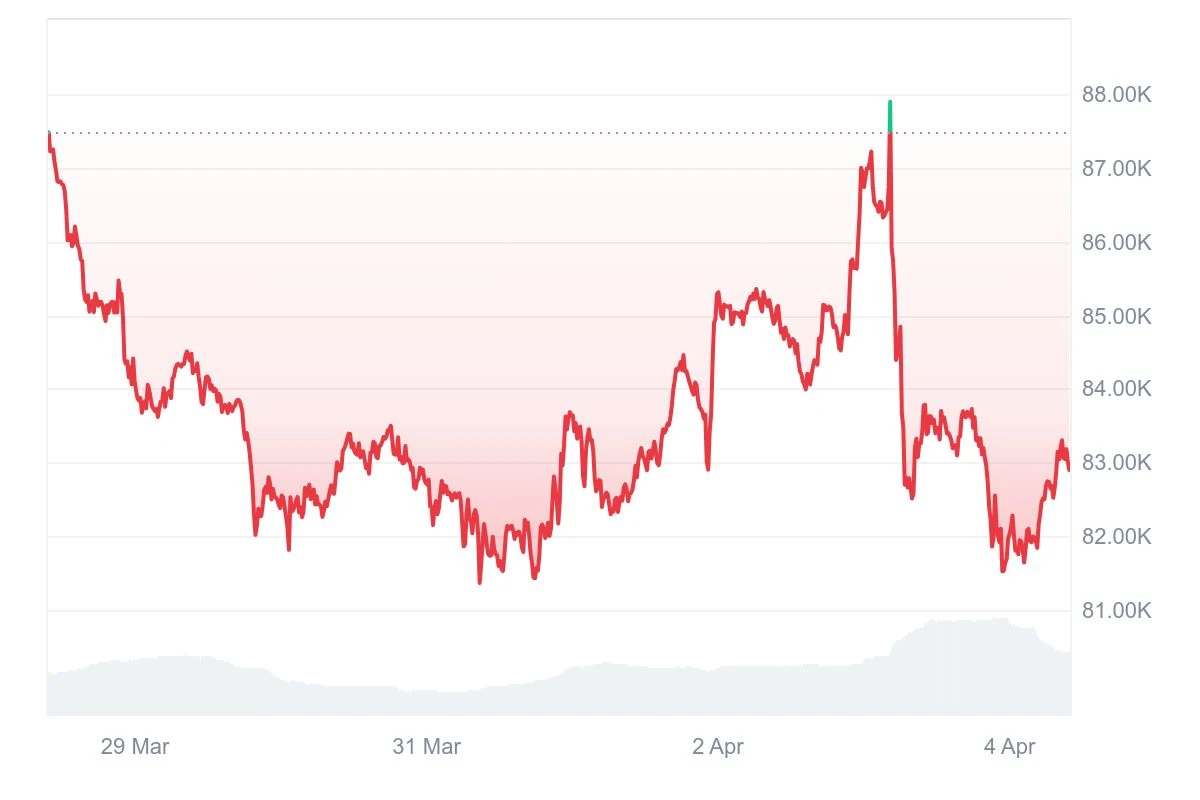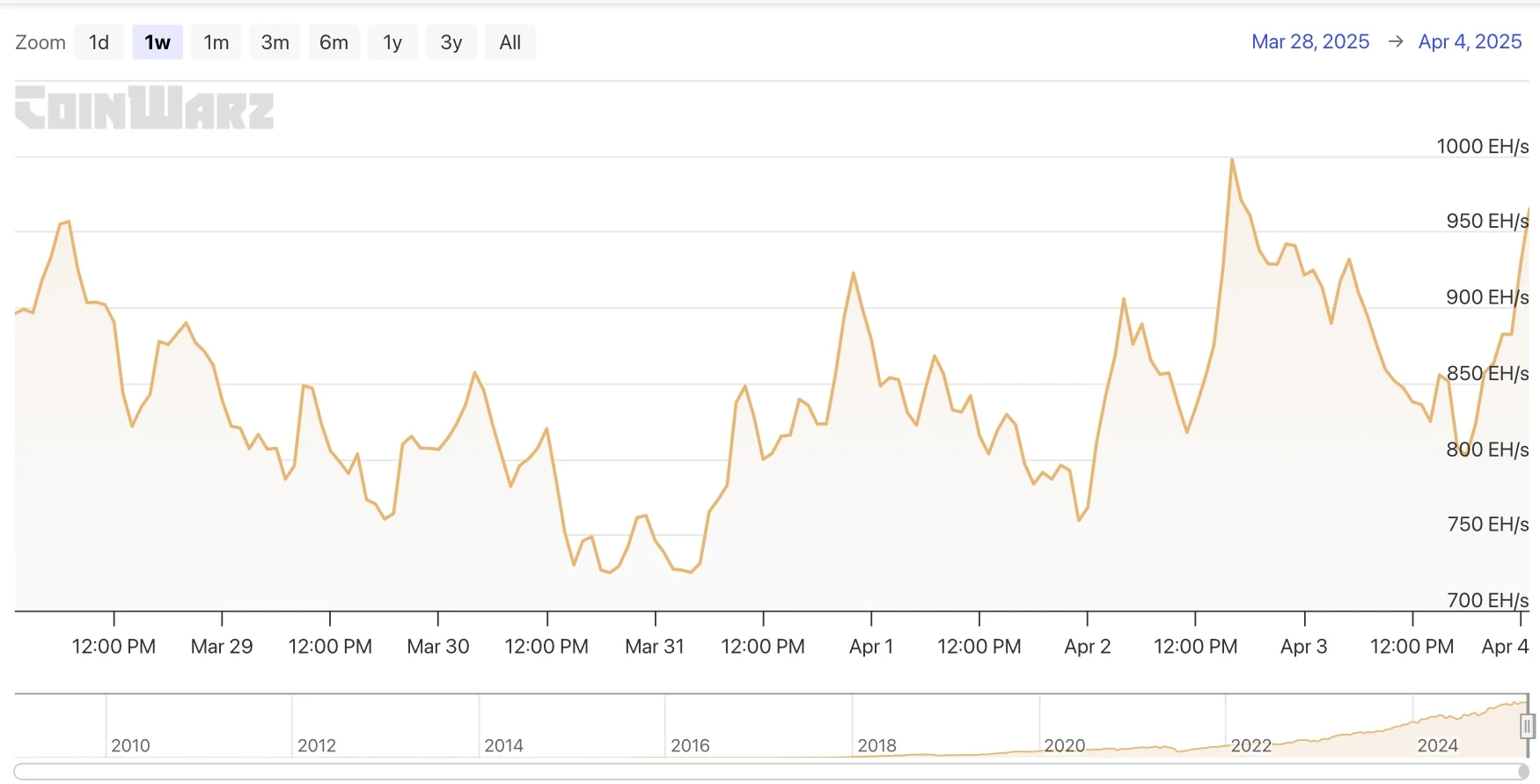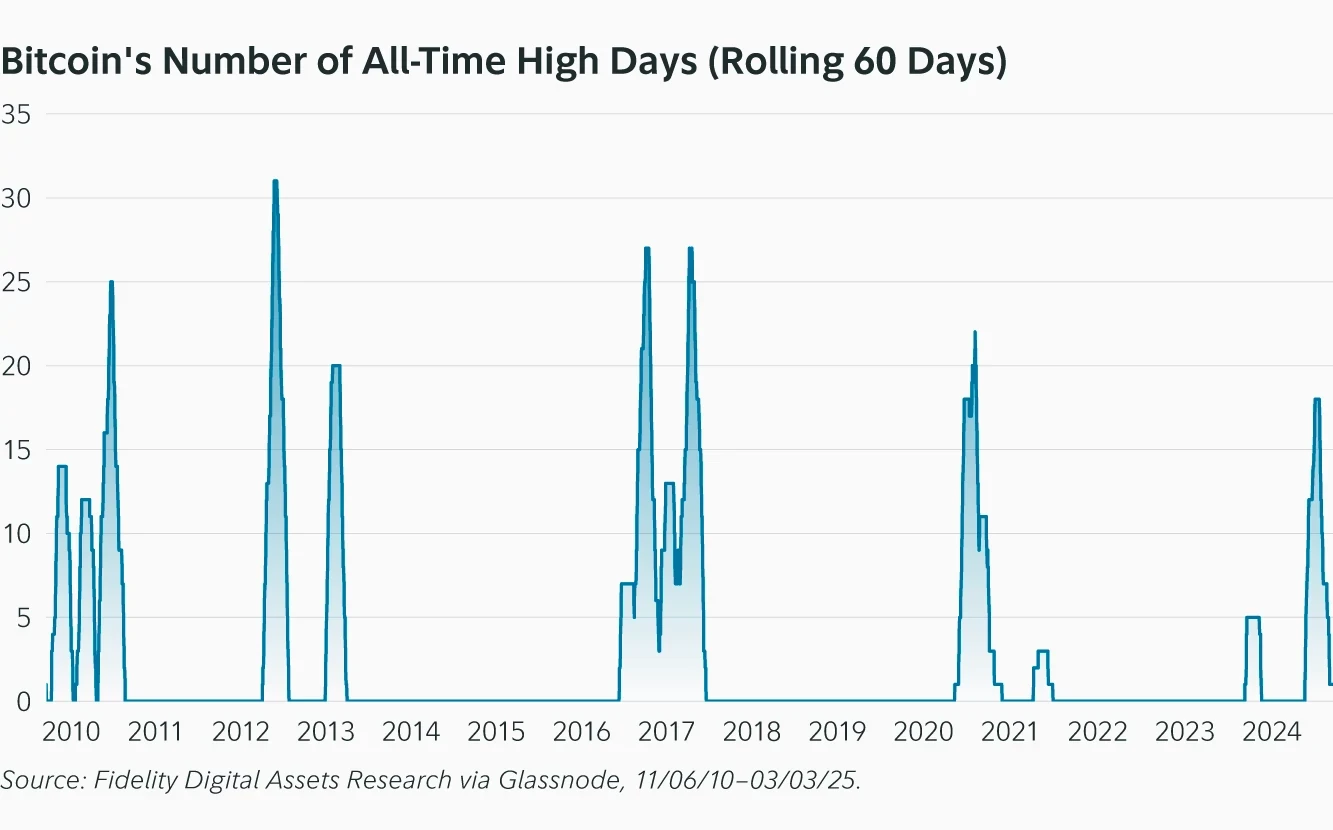1. Bitcoin Market
From March 29 to April 4, 2025, the specific trend of Bitcoin is as follows:
March 29: After falling in the previous trading day, the price of Bitcoin stabilized around $83,840 and briefly rebounded to $84,543. However, the rebound was limited, and then entered a new round of decline, breaking the $84,000 support level, fluctuating down to $82,014, and continued to decline after a slight rebound, reaching a low of $81,878.
March 30: Bitcoin price showed some signs of stabilization. The $82,000 support level was temporarily effective, stopping the decline and entering a shock upward phase. The price once rebounded to $83,478, and then fell back to $82,270.
March 31: Bitcoin officially fell below the key support level of $82,000. After opening, it maintained a volatile downward trend, falling to $81,491 in the early morning. Then, the market was in fierce competition between bulls and bears. In the evening, it further fell to $81,459 before stopping the decline and starting a rebound trend, showing a volatile upward pattern, and quickly rose to $83,633 at noon.
April 1: Bitcoin price briefly consolidated around $83,470, but after failing to stabilize, it weakened again and fell back to $82,314. Then a new round of rising market started, breaking through the previous high, reaching a high of $85,291. During this period, it fell sharply to $82,692, but quickly recovered and successfully broke through the integer mark of $85,000.
April 2: The price once consolidated around $85,000, and then fluctuated down to $83,989. After the short-term correction, it quickly rose and broke through the $86,000, $87,000 and $88,000 levels, showing strong bullish momentum.
April 3: Bitcoin continued to rise, reaching an intraday high of $88,377, but then there was a sharp correction, and the price quickly fell back to a low of $82,529, forming a cliff-like drop. Although it once rebounded to around $83,600, the market selling pressure was still there, and the price fell below $82,000 again, further bottoming out at $81,532.
April 4: Bitcoin stabilized and prices gradually recovered. At the time of writing, Bitcoin was trading at $82,902, showing signs of short-term market stabilization.
Summarize
This week, the overall trend of Bitcoin showed a typical oscillation structure of fall-rebound-fall again. At the beginning of the week, Bitcoin fell in a step-by-step manner, from the $87,000 area to $82,000, forming a short-term weak pattern; the medium-term price remained between $82,000 and $84,000 and fluctuated and consolidated; the volatility increased significantly in the late week. Although it once broke through $88,000 to set a new stage high, the market risk aversion sentiment heated up due to the impact of the new round of tariff policies announced by former US President Trump, and the price quickly and sharply adjusted, forming a cliff-like decline. The current price stabilized around $82,900. The short-term market sentiment is slightly cautious. The subsequent trend needs to pay attention to the changes in macro policies and the effectiveness of key support levels.

Bitcoin price trend (2025/03/29-2025/04/04)
2. Market dynamics and macro background
Fund Flows
1. Exchange fund flow
Bitcoin spot ETF fund flows (data from Farside Investors):
March 31: Bitcoin spot ETFs saw a total net outflow of approximately $60.6 million.
April 1: Net outflows widened to $157.8 million.
April 2: Market sentiment improves, with net inflows of approximately $334 million.
Bitcoin supply on exchanges:
As of April 1, the Bitcoin supply held on exchanges has fallen to 7.53% of the total supply, the lowest level since February 2018, reflecting reduced selling pressure and increased confidence among long-term holders.
2. Institutional investor trends
GameStop: On March 25, GameStop announced plans to raise $1.3 billion through debt financing to purchase Bitcoin, aiming to use it as a fiscal reserve asset to fight inflation and follow technological and monetary trends. However, the move raised market doubts, causing its stock price to fall by more than 13%.
MicroStrategy: As of March 30, MicroStrategy (now called Strategy) increased its holdings of Bitcoin to 528,185, accounting for more than 2% of the total Bitcoin in circulation. Despite this, Monness Crespi Hardt analyst Gus Gala downgraded its stock rating to sell, noting that the company may face challenges in future financing.
3. Whale account fund movement
Long-dormant Bitcoin movement:
On March 30, CryptoQuant analyst Maartunn reported that about 8,000 long-term unmoved (5-7 years) bitcoins were transferred on a large scale, with a total value of about $674 million. This transfer occurred within a single block, and the market generally believed that it could bring selling pressure, causing market sentiment to turn bearish. However, it could also be an internal adjustment of whale accounts or cold wallets of institutional investors, and it does not necessarily mean a direct sell-off.
Technical indicator analysis
Death Cross: Recently, the 50-day moving average (MA) crossed below the 200-day MA, forming a typical death cross sell signal. This usually indicates that the market may enter a downward trend.
Relative Strength Index (RSI): The current RSI value is around 72, which is close to the overbought area and may indicate the risk of a price correction in the short term.
Support and Resistance Levels: The key support is between $75,815 and $72,856. If the price breaks above the $105,000 resistance, it could further test the $110,000 target.
Market sentiment analysis
1. Market sentiment indicator analysis
Fear Greed Index:
According to CoinMarketCap data, the Fear and Greed Index fell from 27 on March 29 to 24 in the middle of the week, rebounded briefly to 29 on April 2, and then fell back to 24. This fluctuation reflects the continued instability of market sentiment. The market was shrouded in fear in the early stage, and investors lacked confidence due to uncertainty and price fluctuations. The rebound on April 2 may be related to changes in capital flows and short-term buying intervention, but due to the lack of clear upward momentum in the market, fear sentiment once again dominated, indicating that investors as a whole are still cautious and lack confidence in the subsequent trend.
2. Market sentiment analysis
In the past week, the price of Bitcoin experienced dramatic fluctuations, first falling sharply to $82,000, then began to rise on April 1, and briefly touched $88,000 on April 3 before quickly falling back to around $82,500. Overall, market sentiment is still cautious and fearful. Although the rebound in early April boosted confidence, the price failed to stabilize effectively, indicating that the bulls are insufficient and the market selling pressure is still heavy. In this context, short-term traders tend to sell high and buy low, while long-term holders are on the sidelines, waiting for the market trend to become clearer.
Macroeconomic Background
New US tariff policy: On Wednesday (April 2), US President Donald Trump announced a new reciprocal tariff policy for multiple countries. The United States will impose a 10% across-the-board tariff on all imports. Higher rates will be imposed on other countries that are considered to be underperforming in trade. In addition, Trump said that a 25% tariff would be imposed on foreign cars. The news caused the price of Bitcoin to fall rapidly from nearly $88,000 to about $83,000. Cryptocurrency-related stocks also fell, with Strategy (formerly MicroStrategy) down about 7%, Coinbase Global down 6%, and Robinhood down 9%. The market is concerned that these tariffs may curb economic growth and exacerbate inflation, which in turn will affect investors preference for risky assets.
Cryptocurrency options expiration and market volatility: According to reports, more than $14 billion in options contracts expired on Friday this week, which could lead to increased volatility in the cryptocurrency market. In addition, GDP data released on Thursday could also affect market sentiment and trading decisions.
Global liquidity and Bitcoin price trends: According to a report by Merkle Tree Capital, the global M2 money supply has continued to rise since the end of 2024. The Federal Reserve announced that it will reduce quantitative tightening (QT) from $25 billion per month to $5 billion starting in April. This increase in liquidity has a historical lag correlation of about 10 weeks with Bitcoin price increases, which may provide support for Bitcoin prices in the coming months.
US economic data and market expectations: This week, investors will focus on March employment data, new trade policies, corporate earnings reports, and the latest developments in the manufacturing and service industries. In particular, Fridays employment report, Tuesdays job openings data, Wednesdays ADP private sector hiring report, and Thursdays weekly unemployment claims data will provide the market with important clues about the health of the US economy and may affect investors attitudes toward risky assets.
3. Hash rate changes
Between March 29 and April 4, 2025, the Bitcoin network hash rate fluctuated as follows:
On March 29, the Bitcoin network hash rate fell from 862.01 EH/s to 786.65 EH/s, and then rebounded to 848.43 EH/s in the short term, but failed to maintain the upward trend and fell back to 769.28 EH/s, showing high volatility. On March 30, the hash rate rose to 857.02 EH/s, but quickly fell back to 781.84 EH/s due to volatility. Although there were signs of recovery afterwards, it fell again to 730.04 EH/s and remained below 750 EH/s for a long time, which was in a relatively low range, indicating that some miners may temporarily withdraw from the network due to profit pressure. On March 31, the hash rate showed a significant increase, rising rapidly to 848.00 EH/s, and rose again after a short correction, reaching a high of 922.66 EH/s, showing that the activity of miners has recovered. On April 1, the hash rate fell rapidly to 822.27 EH/s, and continued the volatile downward trend, falling to a minimum of 759.35 EH/s, showing an overall weak correction pattern. On April 2, the hash rate rebounded strongly again, rising to 905.68 EH/s, and then fell slightly to 817.41 EH/s, but then rose strongly, reaching a high of 997.51 EH/s during the day, which was the high point of the week, and then adjusted slightly to around 940 EH/s. On April 3, the hash rate fell back to 824.77 EH/s, and then further dropped to 802.10 EH/s, but gradually recovered in the second half of the day, and rebounded to 965.17 EH/s as of the time of writing, showing signs of rapid recovery of computing power.
This week, the overall trend of Bitcoins hash rate showed a shock and fall - rapid recovery - violent fluctuations. In the first half of the week, the hash rate dropped below 750 EH/s, indicating that some miners temporarily left the network during the price adjustment period. As market sentiment warmed up, the hash rate quickly recovered, approaching 1,000 EH/s in the second half of the week, reflecting the high elasticity of the network and the rapid response ability of miners.
We need to continue to pay attention to the impact of subsequent price fluctuations on small and medium-sized miners, as well as the impact of the upcoming difficulty adjustment rhythm on hash rate stability.

Bitcoin network hash rate data
4. Mining income
According to the latest MacroMicro model, as of April 2, 2025, the unit production cost of Bitcoin is about $88,427.27, while the spot price on that day is about $82,900, and the corresponding mining cost-to-price ratio is 1.07. This ratio is significantly higher than 1, indicating that the current market price is lower than the average mining cost of the entire network, the network as a whole is operating below the break-even point, and most miners are in a state of profit compression or loss.
This phenomenon reflects that in the current market environment, miners profit margins have been significantly squeezed, especially miners with high electricity prices or using inefficient equipment, especially small and medium-sized mines that rely on the previous generation of ASIC mining machines, which may have entered a marginal loss or even a full loss range. Historical data shows that when the cost-price ratio is continuously higher than 1, it usually causes a part of the inefficient computing power to exit the market, pushing the computing power of the entire network down, and triggering a downward adjustment of the mining difficulty (Difficulty Adjustment Down) to rebalance the network operation cost and entry threshold.
In addition, it is worth noting that the increase in the Mining Cost-to-Price Ratio often occurs simultaneously with weak market sentiment or a rapid price correction. Therefore, this indicator can also be used as a predictive signal of miners survival pressure and a potential leading indicator of the market bottom, and has a certain forward-looking reference value.
According to Hashrate Index data, as of April 4, 2025, the Bitcoin hash price (Hashprice) is $46.51/PH/s/day, which has rebounded slightly from the previous month, but is still in a relatively low range overall. Hashprice is a core indicator for measuring miners unit computing power income, which is affected by the combined influence of Bitcoin price, mining difficulty and block fees. The recent decline in Bitcoin prices and the increase in difficulty have put pressure on the Hashprice level, further compressing miners profitability.
If the price of Bitcoin cannot rebound effectively in the short term, and energy and maintenance costs remain high, it is possible that some regions will see a trend of computing power migration or centralization. In particular, miners with cheap electricity resources or high-efficiency mining machines will further strengthen their competitive advantages, accelerating the market concentration towards the top.

Bitcoin mining cost data
5. Energy costs and mining efficiency
According to CloverPool data, as of the time of writing, the total computing power of the Bitcoin network has reached about 842.54 EH/s, and the current network mining difficulty is 113.76 T. According to the block interval, the next round of difficulty adjustment is expected to be carried out in about 1 day. The current estimated increase is about + 4.57%, and the difficulty may rise to 118.95 T after the adjustment.
This round of difficulty increase means that the efficiency of mining Bitcoin per unit computing power will further decline, which is manifested in a decrease in output per unit energy consumption (i.e., a decrease in energy efficiency), which is equivalent to a contraction in marginal benefits for miners. Against the backdrop of relatively pressured Bitcoin prices, this trend will increase the profit pressure on mining farms with high electricity prices and high operating costs, especially for miners who fail to deploy high-efficiency ASIC equipment in a timely manner, and the potential risks will increase significantly.
According to the current difficulty and computing power level, the average block time of the network is still slightly faster than 10 minutes, which is also a direct factor that drives the difficulty to increase further. At the same time, as the major mining areas in the world gradually enter the spring and summer, the dry season of hydropower in some areas ends, and computing power resources may continue to be released in the short term, further pushing up the difficulty level of the entire network.
In addition, it is worth noting that if the price of Bitcoin remains at the current level (about US$82,900) or continues to fall back, and the network difficulty continues to rise, it will directly lead to a continuous decline in Hashprice (mining income per EH/s per day), thereby compressing the unit energy consumption income of miners.
As Bitcoin is about to enter an important cycle window of halving (expected to be mid-April 2025), the above trends will be more influential, and miners need to optimize their energy structure and equipment iteration strategy in advance to adapt to the upcoming dual challenges of halving of unit output + increasing difficulty.

Bitcoin mining difficulty data
6. Policy and regulatory news
US Bitcoin legislation accelerates: multiple states promote self-custody rights and government investment
California Submits Bitcoin Rights Act - Establishing Self-custody Rights and Limiting Government Intervention
On March 29, 2024, the California State Assembly formally submitted the Bitcoin Rights Act, numbered AB-1052, which aims to protect California residents right to self-custody over Bitcoin and other digital assets and prohibit the government from levying taxes or imposing restrictions on the use of Bitcoin payments. The bill also establishes a legal framework for the treatment of unclaimed digital assets and amends the Political Reform Act of 1974 to clarify that public officials may not promote or issue digital assets. Supporters believe that if the bill is passed, it will become a reference model for national Bitcoin regulation.
Rhode Island plans to introduce a tax-free policy for Bitcoin transactions - a monthly quota of $10,000 to encourage businesses to adopt
In March 2024, the Rhode Island Senate submitted Bill No. 0451, proposing to allow residents and businesses to be exempt from state capital gains tax on up to 10 Bitcoin transactions per month, with a single transaction amount not exceeding $1,000. The bill emphasizes that the policy only applies to state taxes and does not affect federal tax obligations. It also requires that transaction records be kept intact for tax audits. Chris Perrotta, chairman of the Rhode Island Blockchain Committee, said that the move will lower the barriers to Bitcoin transactions and encourage more companies to accept Bitcoin payments, giving the state a favorable position in the blockchain economic competition.
Texas proposes government Bitcoin investment bill — plans to build $250 million BTC reserve
On April 2, 2024, Democratic members of the Texas House of Representatives submitted a new bill proposing that the state government invest up to $250 million in Bitcoin and allow cities and counties to invest up to an additional $10 million. The bill aims to include Bitcoin in public funding allocation to enhance fiscal diversification and long-term profit potential. If the bill is passed, Texas will become the first state in the United States to formally establish a Bitcoin government reserve, and may trigger discussions in other states about Bitcoin as a strategic asset.
Arizona House Committee of the Whole Passes Bitcoin Reserve Bill — Enters Final Vote
On April 3, 2024, the Arizona House of Representatives Committee officially passed the Bitcoin Reserve Act (SB 1025 and SB 1373). The bill has now entered the third reading process and will be subject to a final vote in the House of Representatives. If successfully passed, it will be submitted to the governor for signature, making Arizona an important promoter of the US Bitcoin fiscal strategy.
Alabama, Minnesota Lawmakers Push for Bitcoin Reserves — Allowing States to Invest in Bitcoin
On April 3, 2024, lawmakers in Minnesota and Alabama have submitted supporting bills identical to existing bills to allow states to purchase Bitcoin. On April 1, Minnesota Republican Congressman Bernie Perryman submitted the Minnesota Bitcoin Act (HF 2946) to the state House of Representatives, after Republican state Senator Jeremy Miller introduced an identical bill on March 17. Meanwhile, on the same day in Alabama, Republican Senator Will Barfoot introduced Senate Bill 283, while bipartisan House members led by Republican Mike Shaw introduced the same House Bill 482, which allows the state to invest in cryptocurrencies, but essentially limits it to Bitcoin.
A senior Brazilian official: Bitcoin reserves are crucial to Brazils prosperity
On March 29, according to Decrypt, Pedro Giocondo Guerra, senior adviser to the Brazilian Vice President, said on behalf of the government in a recent speech: The strategic reserve of Bitcoin is essential to national prosperity. Discussions on the establishment of BTC reserves may be a key factor in determining Brazils prosperity and are in the interests of the country and the public. Brazilian congressman Eros Biondini (PL-MG) previously proposed a legislation proposing the establishment of a Strategic Sovereign Bitcoin Reserve (RESBit). By holding 5% of foreign exchange reserves (international reserves) in Bitcoin, the Brazilian Central Bank will use advanced monitoring systems, blockchain technology and artificial intelligence to monitor transactions and be responsible for custody.

Related images
Bitcoin adoption in EU limited by ‘fragmented’ regulatory regime
March 29 news, although the United States is advancing landmark cryptocurrency regulations, trying to establish Bitcoin as a national reserve asset, the institutional adoption of Bitcoin in the European Union is still slow. Since President Trump signed an executive order on March 7, planning to use confiscated cryptocurrencies to create a federal Bitcoin reserve, European companies have mostly remained silent on this.
According to Elisenda Fabrega, general counsel at Brickken, a European real-world asset tokenization platform, this stagnation may stem from Europe’s complex regulatory regime. She said: “Bitcoin adoption by European businesses remains limited, and this hesitation reflects deeper structural divisions rooted in regulation, institutional signaling, and market maturity. Europe has yet to take a clear position on Bitcoin as a reserve asset.”
7. Mining News
Galaxy Digital plans to scale down Bitcoin mining, and its Texas data center will turn to AI-related businesses
On March 29, Galaxy Digitals financial report disclosed that the company plans to reduce Bitcoin mining output in the next few quarters and transform its data center in Texas into an AI and high-performance computing (HPC) facility. This transformation is based on a 15-year hosting agreement signed with CoreWeave.
Hut 8 Mining and Trumps second son announced the establishment of a US Bitcoin company
On March 31, Hut 8 Mining and Eric Trump, the second son of US President Trump, announced the establishment of American Bitcoin, which aims to set new standards for Bitcoin mining. American Data Centers, owned by Trumps eldest and second sons, will merge with American Bitcoin and hold a 20% stake in it.
American Bitcoin is a mining operation majority-owned by publicly traded crypto mining company Hut 8. Together, they plan to create the world’s largest digital currency mining operation and intend to build their own “Bitcoin Reserve.”
JPMorgan Chase: The market value of 14 listed Bitcoin mining companies shrank by 25% in March
On April 2, according to Decrypt, JPMorgan Chase said in a report on Tuesday that Bitcoin miners continue to face challenges, and 14 listed mining companies in the field collectively experienced the worst month on record in March. The Bitcoin miners it tracks, including companies such as MARA and Core Scientific, saw their market value shrink by 25% in total last month, or about $6 billion. In addition, the report stated that companies with high-performance computing businesses performed worse than pure Bitcoin miners for the second consecutive month.
The 14 listed miners also had a rough February, when they also lost more than 20% of their combined market value, also about $6 billion, according to JPMorgan Chase Co.

Related images
US Senators introduce FLARE Act to support Bitcoin mining industry development
On April 2, U.S. Senator Ted Cruz recently announced the launch of the Promoting the Utilization of Lower Atmospheric Emissions (FLARE) Act, a federal proposal that aims to transform wasted energy into efficient use through targeted tax reforms. The federal bill seeks to: amend the Internal Revenue Code of 1986 to provide for the permanent full expense of property used to capture natural gas that would otherwise be burned or emitted and use it for value-added products. Cruz described the move as a strategic step to take advantage of the states abundant energy supply and strengthen its leadership in the digital asset field. The congressman said: I am committed to making Texas the preferred place for Bitcoin mining. The FLARE Act incentivizes entrepreneurs and cryptocurrency miners to utilize natural gas that would otherwise be stranded.
8. Bitcoin related news
Bitcoin holdings of global companies and countries (statistics for this week)
1. Fidelity increases its Bitcoin holdings: On March 29, Fidelity purchased nearly $100 million worth of Bitcoin, bringing the total value of its Bitcoin ETF (FBTC) holdings to $16.6 billion.
2. El Salvador’s Bitcoin holdings: As of March 30, El Salvador held 6,131.1 bitcoins (about $505 million). As of March 31, the holdings increased to 6,132.18 bitcoins (about $606 million).
3. Metaplanet increases its holdings of Bitcoin: On March 31, Metaplanet issued 2 billion yen (about 13.38 million U.S. dollars) of zero-interest bonds to purchase Bitcoin. On April 1, Metaplanet purchased 696 Bitcoins, bringing its total holdings to 4,046, with an average cost of about $86,300 per Bitcoin. On April 2, Metaplanet increased its holdings by another 160 Bitcoins, bringing its total holdings to 4,046, with an average cost of about $86,300 per Bitcoin.
4. Japanese game developer enish will buy Bitcoin: On April 2, according to an official announcement, Japanese listed game developer enish announced that it would incorporate Bitcoin into its financial strategy and planned to purchase 100 million yen (about 670,000 US dollars) worth of Bitcoin between April 1 and 4. The company positioned the purchase of Bitcoin as an important part of its overall financial strategy.
BlackRock CEO promises to unlock private investment opportunities for the masses, says dollar could be replaced by assets like Bitcoin
On March 31, BlackRock CEO Larry Fink promised to open private markets to millions of everyday investors, not just a few wealthy people, and believed that individuals should share more of the benefits of economic growth. He said that in recent years, capitalism serves only a few people, causing anxiety to spread throughout the economy. He said that economic uneasiness is more serious than any time in recent times, and expanding investment channels will help ease concerns.
In his annual letter to investors on Monday, Larry Fink also mentioned that the U.S. dollars status as the worlds reserve currency is not guaranteed to last forever, and warned that the country needs to control its debt. He also suggested that the dollar could lose its status and be replaced by digital assets such as Bitcoin.

Related images
Survey: 25% of Hong Kong respondents want to hold virtual assets, with Bitcoin being the most popular
On April 1, the Hong Kong University of Science and Technology School of Business and Management released a public opinion survey on virtual assets and tokenized currencies, showing that about 25% of respondents said they hope to hold virtual assets in the future, an increase of 6 percentage points compared to the suspected fraud involving a cryptocurrency platform in mid-September 2023. The survey results pointed out that 81% of respondents are interested in holding Bitcoin, an increase of 7 percentage points from the first survey, and respondents interest in non-fungible tokens (NFTs) has weakened, down 11 percentage points from the first survey, reflecting that investors preferences have shifted from speculative digital collectibles to other areas.
Arthur Hayes: Still Believes Bitcoin Can Reach $250,000 by the End of the Year
On April 1, BitMEX co-founder Arthur Hayes said in his latest blog post: Bitcoin value = technology + legal liquidity. This technology works and will not undergo any major changes in the near future, whether good or bad. Therefore, Bitcoin trading is entirely based on the markets expectations of future legal currency supply. If my analysis of the Feds major shift from Treasury QT to QE is correct, then Bitcoin hit a local low of $76,500 last month, and now we are starting to move towards $250,000 by the end of the year. Of course, this is not an exact science, but if I take gold as an example, if I have to bet between whether I think Bitcoin will hit $76,500 or $110,000 first, I will bet on the latter. Even if the U.S. stock market continues to fall due to tariffs, collapsing earnings expectations, or falling foreign demand, I still believe that Bitcoin has a greater probability of continuing to climb. Recognizing the pros and cons, Maelstrom is deploying capital cautiously. We do not use leverage, and we make small purchases relative to the size of our total portfolio. We have been I am buying Bitcoin and altcoins at all levels between $90,000 and $76,500. The pace of capital deployment will speed up or slow down depending on the accuracy of my forecast. I still believe that Bitcoin can reach $250,000 by the end of the year.”
Fidelity Research: Bitcoin is preparing to enter the next acceleration phase
On April 1, Fidelity Digital Assets research showed that the Bitcoin bull market is not over yet because the acceleration cycle has not yet peaked. A report from Fidelity Digital Assets questioned whether Bitcoin prices have already experienced a cyclical peak or whether Bitcoin is on the verge of another acceleration phase.
According to Fidelity analyst Zach Wainwright, Bitcoin’s acceleration phase is characterized by “high volatility and high returns,” similar to the price action that occurred when Bitcoin surpassed $20,000 in December 2020. Although Bitcoin’s year-to-date returns are a loss of 11.44% and the asset is down nearly 25% from its all-time high, Wainwright said the performance after the recent “acceleration phase” is consistent with Bitcoin’s average retracement compared to previous market cycles.

Related images
Trumps second son: Bitcoin is one of the greatest means of storing value
On April 2, Trump’s second son Eric Trump said: “Bitcoin is one of the greatest means of storing value, it is highly liquid, and it is an excellent hedging tool for real estate.”
Fidelity Research Analyst: Bitcoin may enter an acceleration phase, and the base price may stabilize at $110,000
On April 3, according to Bitcoin.com, Fidelity Digital Assets Research Analyst Zack Wainwright said that Bitcoin may be in an accelerated phase, showing high volatility and profit-making characteristics, similar to the price breakthroughs in 2013 and 2017. He pointed out that the price of Bitcoin rose 56% after the election. If it enters a second rebound, the base price may be around $110,000, and it is expected to reach a peak in the next few months.










